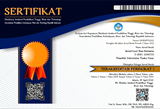ANALISIS KELIMPAHAN, KOMPOSISI DAN SUMBER SAMPAH LAUT: STUDI KASUS PADA PANTAI KUALA BATU DESA PULAU KAYU KABUPATEN ACEH BARAT DAYA
Abstract
Sampah laut telah menjadi masalah dan ancaman bagi ekosistem, keanekaragaman hayati maupun kehidupan laut. Oleh sebab itu, diperlukan kebijakan, strategi mitigasi dan rencana aksi yang tepat untuk mengatasi masalah tersebut. Tujuan Penelitian ini adalah untuk mendapatkan gambaran tentang jumlah, komposisi dan sumber sampah laut yang nantinya dapat dijadikan referensi untuk mengatasi masalah sampah laut. Penelitian ini dilaksanakan di Pantai Kuala Batu, Desa Pulau Kayu Kabupaten Aceh Barat Daya. Metode pengumpulan sampel ditetapkan berdasarkan protokol penelitian oleh NOAA Marine Debris Shoreline Survey Field Guide (2012). Hasil penelitian ini menunjukkan bahwa jumlah sampah laut yang terkumpul selama penelitian adalah 232 item/1.200 m2 dan densitasnya 0.193 item/m 2. Sampah plastik merupakan jenis sampah laut dengan jumlah tertinggi yaitu 79% dan sumber sampah laut tertinggi di pantai ini berasal dari daratan (land-based sourced) melalui kegiatan rekreasi dan aktivitas pantai yaitu 79%.
Full Text:
PDFReferences
Assuyuti, Y.M., Reza, B.Z., Muhammad, A.T., Azkiya, B., and Pangestuti, U. 2018. “Distribusi dan jenis sampah laut serta hubungannya terhadap ekosistem terumbu karang Pulau
Pramuka, Panggang, Air, dan Kotok Besar di Kepulauan Seribu Jakarta”. Majalah Ilmiah Biologi Biosfera : A Scientific Journal, 35(2): 91-102.
Barnes, D.K.A., Galgani, F., Thompson, R.C., and Barlaz, M. 2009. “Accumulation and fragmentation of plastic debris in global environments”. Philosophical Transactions the Royal Society Publishing, 364: 1985–1998.
Corcoran, P.L., Biesinger, M.C., and Grifi, M. 2009. “Plastics and beaches: a degrading relationship”. Marine Pollution Bulletin, 58: 80–84.
Derraik, J.G.B. 2002. “The pollution of the marine environment by plastic debris: A review”. Marine Pollution Bulletin, 44(9) :842-52.
Djaguna, A., Wilmy, E. Pelle., Joshian, N.W.S., Hermanto, W.K.M., Natalie, D.C.R., and Erwin, L.A.N. 2019. “Identifikasi sampah laut di pantai tongkaina dan talawaan bajo”. Jurnal Pesisir dan Laut Tropis, 7(3): 174-182.
FAO. 2017. Microplastics in Fisheries and Aquaculture: Status of Knowledge on Their Occurrence And Implications for Aquatic Organisms and Food Safety. Rome: Food and Agriculture Organization.
Fitria, R., Diana, F., Riani, E., Yulianto G., and Najmi, N. 2019. “Analysis of sources and composition of marine debris in western and southern Aceh, Indonesia”. IOP Conf. Series: Earth and Environmental Science, 404: 1-7.
Hardesty, B.D., Lawso, T.J., Tonya, V. D.V., Matt, L., and Chris, W. 2016. “Estimating quantities and sources of marine debris at a continental scale”. Frontiers in Ecology and the Environment, 15 (1): 18-25.
Kuo, F.J., and Huang, H.W. 2014. “Strategy for mitigation of marine debris: analysis of sources and composition of marine debris in northern Taiwan”. Marine Pollution Bulletin, 83: 7078.
Laglbauer, B.J.L., Melo, F. R., Andreu-Cazenave, M., Brunelli, L., Papadatou, M., Palatinus, A., Grego, M., Deprez, T. 2014. “Macrodebris and microplastics from beaches in Slovenia”. Marine Pollution Bulletin, 89: 356–366.
Law, K.L., Morét-Ferguson. S., and Maximenko, N.A. 2010. “Plastic accumulation in the north atlantic subtropical gyre”. Science, 329: 1185–88.
Liu, T.-K., Wang, M.W., Chen, P.. 2013. “Influence of waste Management policy on the characteristics of beach litter in Kaohsiung, Taiwan”. Marine Pollution Bulletin, 72:99– 106.
Munari, C., Corinne, C., Umberto, S., and Michele, M. 2016. “Marine litter on Mediterranean shores: Analysis of composition, spatial distribution and sources in north-western Adriatic beaches”. Waste Management, 49:483-490.
Opfer, S., Courtney, A., and Sherry, L. 2012. NOAA Marine Debris Shoreline Survey Field Guide NOAA Marine Debris Program. USA: Silver Spring.
Pawar, P.R., Sanket, S.S., and Rahul, B.P. 2016. “Plastic marine debris: sources, distribution and impacts on coastal and ocean biodiversity”. Proceedings of the Royal Society: Biological Sciences, 3:54-40.
Ramirez-Llodra, E., Company, J.B., Sarda` F., De Mol, B., Coll, M. 2013. “Effects of Natural and Anthropogenic Processes in the Distribution of Marine Litter in the Deep Mediterranean Sea”. Progress in Oceanography, 118: 273–287.
Rochman, C.M., Akbar, T., Susan, L.W., Dolores, V.B., Rosalyn, L., Jeffrey, T.M., Foo-Ching, T., Shinta, W., and Swee, J.T. 2015. “Anthropogenic debris in seafood: plastic debris and fibers from textiles in fish and bivalves sold for human consumption”. Scientific Report, 5:1-10.
Shuker., Iain, G., Cadman., Anne, C. 2018. Indonesia-Marine debris hotspot rapid assessment: synthesis report (English) Marine Debris Hotspot Rapid Assessment (Synthesis Report). Washington: World Bank Group.
The Ocean Conservancy. 2010. Trash Travell From Our Hands to the Sea, Around the Globe, and Through Time. Washington: Conservation International.
Zhou, P., Chuguang, H., Hongda, F., Weixu, C., Dongmei, L., Xiaomin, L., Hansheng, Y. 2011 “The abundance, composition and sources of marine debris in coastal seawaters or beaches around the northern South China Sea (China)”. Marine Pollution Bulletin, 62(9) :19982007.
DOI: https://doi.org/10.35308/jlaot.v2i1.2361
Refbacks
- There are currently no refbacks.
Copyright (c) 2020 Fitria Rahmayanti, Farah Diana, Nurul Najmi, Etty Riani, Gatot Yulianto, Munandar Munandar
Jurnal Laot Ilmu Kelautan
e-ISSN: 2684-7051 I DOI: 10.35308
Jl. Alue Peunyareng, Ujong Tanoh Darat, Meureubo, Kabupaten Aceh Barat, Aceh 23681, Indonesia
(0655) 7110535 l l +6282268863033
 is licensed under a Creative Commons Attribution-ShareAlike 4.0 International License
is licensed under a Creative Commons Attribution-ShareAlike 4.0 International License













